Chevrolet Captiva Service & Repair Manual: Upper Frame Rail
| Do not damage any inner panels
or reinforcements. |
| If the location of the original
plug weld holes can not be determined, space the plug weld holes every 1
1/2 inches apart. Some panels may have structural weld thru adhesive. It
is required to replace the weld thru adhesive with an additional spot weld
between each factory spot weld. |
Removal
| 2. |
Disconnect battery ground. |
| 3. |
Remove all related panels and components. |
| 4. |
Repair as much damage as possible to
factory specifications. |
| 5. |
Remove sealers and corrosion protection
materials from repair area. |
| 6. |
Locate and drill out all factory welds.
Note number and location of welds for installation of front upper
outer rail, Fig. 1. |
| 7. |
Remove damaged front upper outer rail,
Fig. 2. |
|
Installation
| 1. |
Drill 5/16 inch holes for plug weld
as required on service component, in locations noted from original
assembly, Fig. 3. |
| 2. |
Prepare all mating surfaces as required. |
| 3. |
Apply 3M® Weld Thru Coating P/N 05916,
or equivalent, to all mating surfaces. |
| 4. |
Position front upper outer rail to
vehicle using three dimensional measuring equipment. Clamp front
upper outer rail into place, Fig. 4. |
| 5. |
Plug weld accordingly, Fig.
5. |
| 6. |
Clean and prepare all welded surfaces. |
| 7. |
Apply sealers and corrosion protection
materials to repair area, as required. |
| 8. |
Refinish repaired area. |
| 9. |
Install all related panels and components. |
| 10. |
Connect battery ground. |
|
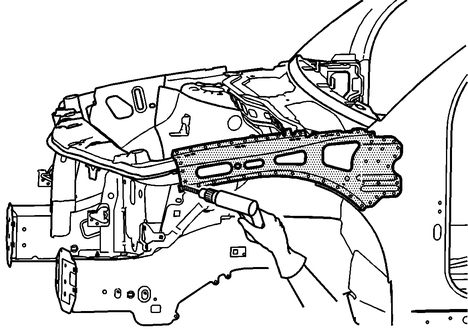
Fig.
1 Upper frame rail weld locations
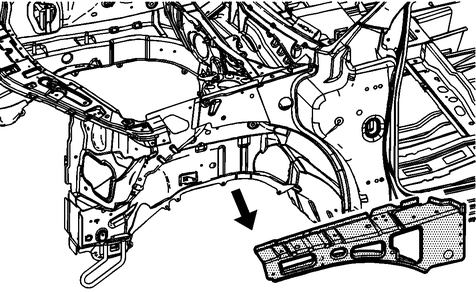
Fig.
2 Upper frame rail removal
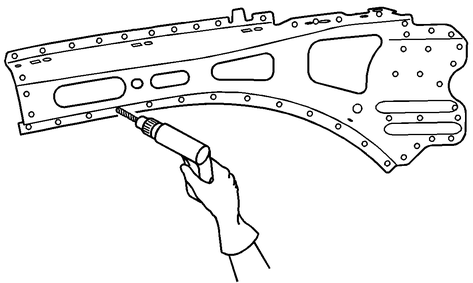
Fig.
3 Upper frame rail preparation
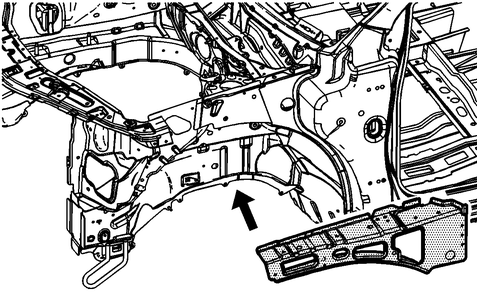
Fig.
4 Upper frame rail installation
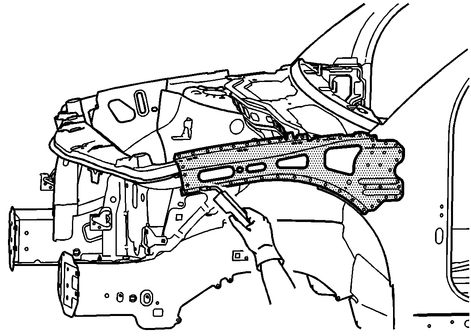
Fig.
5 Upper frame rail plug weld locations
Removing the upper frame rail typically involves several steps to ensure safe and effective disassembly. This includes securing the vehicle on jack stands or a lift to provide adequate clearance and stability. Technicians will disconnect any electrical connectors, hoses, or components attached to the upper frame rail before removing fasteners or bolts that secure it to the vehicle's structure. Careful handling and lifting equipment may be necessary to safely extract the old upper frame rail from the vehicle without causing damage.
When installing a new upper frame rail, precision and attention to detail are crucial. Technicians must ensure the replacement part aligns perfectly with the mounting points on the vehicle's structure before securely fastening it in place with bolts or fasteners. Reconnecting electrical connectors, hoses, and components correctly is essential to restore functionality and integrity. A final inspection is performed to verify that the upper frame rail is properly aligned and secured, and the vehicle is lowered back to the ground if it was lifted during the process.
It's important to note that these procedures may vary depending on the specific model year and trim of the Chevrolet Captiva, and professional guidance from a certified mechanic or consulting the vehicle's service manual is recommended for accurate and safe repairs.
If the location of the original
plug weld holes cannot be determined, or if structural weld thru adhesive
is present, space the plug weld holes every 1 1/2 inches apart.
Removal
...
Do not damage any inner panels
or reinforcements.
If the location of the original
plug weld holes can not be determined, space the plug weld holes every 1
1/2 inches ap ...
More about:
Chevrolet Captiva Owners Manual > In Brief: Instrument Panel
Instrument Panel Overview
Air Vents on page 8-9.
Instrument Panel Illumination
Control on page 6-4.
Turn Signal Lever. See Turn and
Lane-Change Signals on
page 6-3.
Instrument Cluster on page 5-9.
Windshield Wiper/Washer on
page 5-3.
AM-FM Radio on page 7-5.
Auxiliary Inp ...





 Roof
Roof Upper Tie Bar
Upper Tie Bar